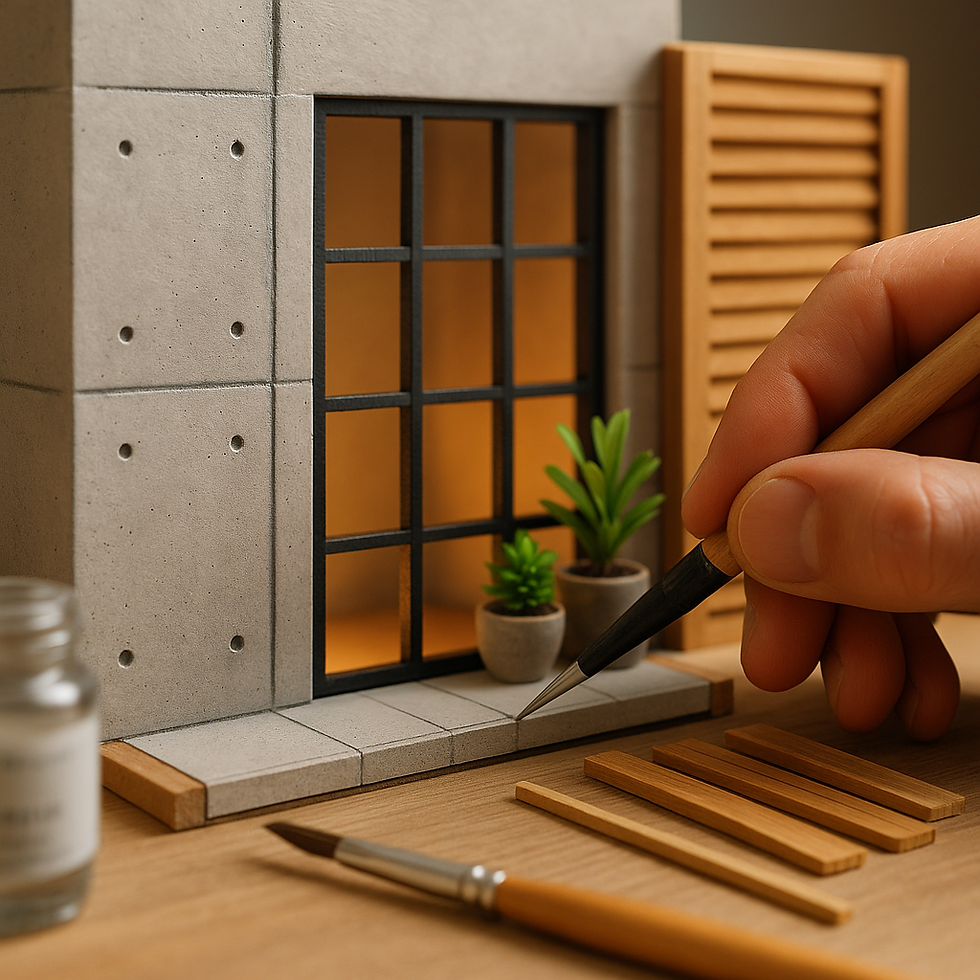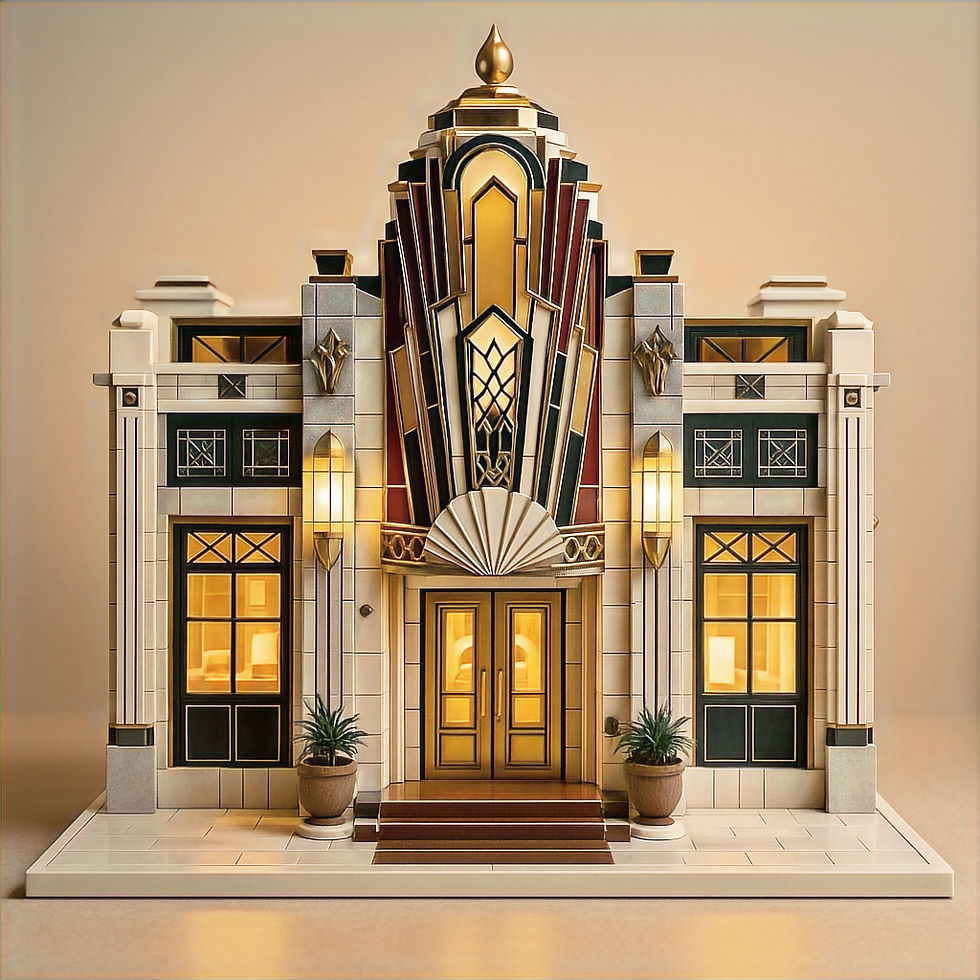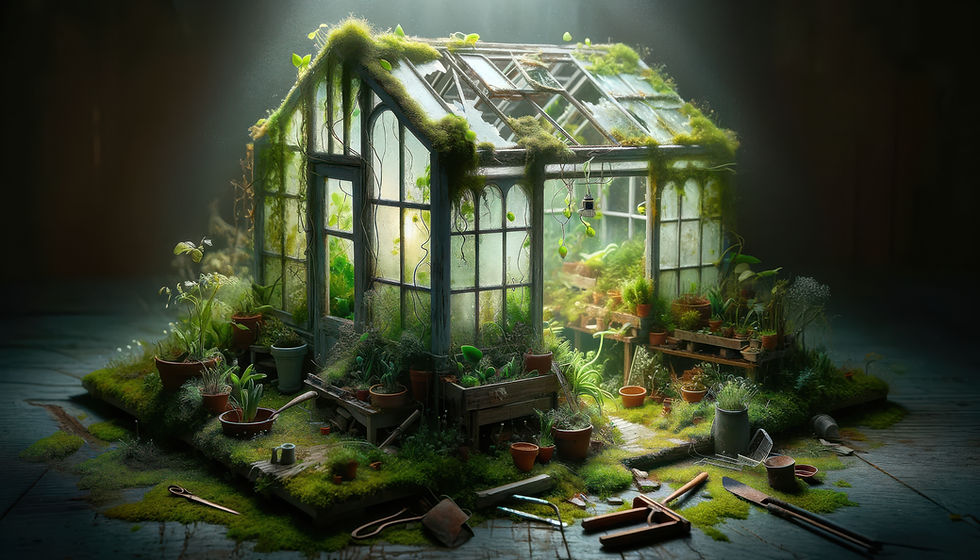Concrete, Cozy, and Clever: A Modern Industrial Miniature You’ll Want to Move Into
- Brandon

- Mar 5, 2024
- 9 min read
Updated: Aug 25
First Impressions in Miniature
If a tiny architect binge-watched Scandinavian loft tours and then learned bonsai, you’d get this modern industrial miniature home and garden. Concrete panels with tidy form-tie dots meet black steel window grids; warm slatted wood softens the edges; and the whole thing is draped in greenery that looks like it’s plotting a gentle takeover. It’s the good kind of contrast: cool concrete next to sunlit curtain glow; hard edges softened by dangling vines. Think “miniature urban courtyard,” “miniature concrete façade with seams,” and “miniature steel factory windows,” all playing nicely together on one compact stage.
The palette is a civilized truce—graphite, ash, and cement gray lifted by caramel wood and soft plant greens. The glazing lines are crisp, the balconies are believable, and the lighting? Chef’s kiss. There’s that we-live-here look: stacked planters, a stray watering can, ceramic mugs waiting on a low table, and a sofa that’s clearly seen at least three late-night miniature movie marathons. You can practically smell fresh coffee and wet potting soil. It’s modern, it’s industrial, and it’s cozy in the way only a well-loved 1:12-ish scale loft can be.
Why This Photo Gets VIP Treatment
You’re seeing a web-optimized image—perfect for browsing, snacking, and saving to your “someday miniature modern loft” vision board. But if you want to see the micro-brushstrokes in those concrete seams and every filament glow in the hanging bulbs, I’ve got you: order the high-resolution canvas print. It lands ready to hang (FREE U.S. shipping), and it turns a blank wall into a warm focal point—like a window into a much smaller, tidier universe where no one leaves dishes in the sink. https://www.smallworldminiatures.com/product-page/concrete-cozy-and-clever-a-modern-industrial-miniature-home-canvas-print
The Tiny Tale (Because Every Home Has One)
Meet Gravel & Ivy, a pocket-sized live-work loft founded—legend says—in 1978 when a retired toy train mechanic named Marta Rivett swapped her last brass coupler for a fistful of pothos cuttings. Marta turned an empty concrete box into a plant-friendly studio for fellow tinkerers who kept “improving” their roommates’ appliances (sometimes explosively). Over time a community formed: Rook, the night-shift ceramicist who fires mugs at 3 a.m.; Jaz, who welds shelves out of bicycle spokes; Auntie Kei, who sneaks plums to the bonsai and insists it nods back.

By the 1990s, Gravel & Ivy was famous for its Light Swap Thursdays—bring a bulb, trade a fixture—hence the mismatched pendant party across the decks. You’ll also spot a tradition in progress: a single ceramic bell (left side, by the trellis). When newcomers ring it, someone yells, “Welcome home!” and hands them a plant they’re absolutely not ready for.
Easter-egg hunters: keep an eye out for a tiny mug with a crooked handle on the lower terrace and a ladder with four rungs hiding near the back—Rook made both on an off day. If you find the minuscule “Do not feed the pigeons” scrawl tucked behind the shutter slats, you win…well, bragging rights and an approving nod from Auntie Kei.
Composition & Materials: A Guided Tour
Let’s walk it left to right, top to bottom, like a gallery docent who secretly wants you to start building the moment you finish reading.
Far Left: A timber trellis kicks things off, climbing from the deck to a cantilevered arm with an industrial shade. The trellis frames a stepped stoop—note the shallow risers that sell scale—and a vertical herb rack. Planters vary in height and diameter, which keeps the eye bouncing without chaos. You can spot light vine tendrils curling around slats; they cast delicate shadows that read beautifully in photos.

Upper Left Balcony: Wooden shutters slide across a boxy cut-out—smart move. Shutters give you rhythm and, when partially closed, that “someone lives here” privacy. The rail is basically a row of planters, a trick I love for miniature urban balconies: it hides balcony thickness and gives you a gorgeous silhouette.
Center Section: The concrete façade is panelized with clean seam lines and form-tie impressions—those tiny dimples that whisper “We used nice plywood and a square.” A black steel canopy frames the glass-box lounge, where plants gobble all the light like it’s brunch. Notice how the steel grid lines align with the panel seams—subtle harmony that professional architects get applauded for and diorama nerds (hi, it’s me) swoon over.

Lower Center: The open deck becomes a stage for warm bulbs strung from simple downward stems. The slightly irregular hanging lengths avoid the dreaded “soldier line” effect. Behind them, a soft curtain glow creates depth, and the gap around the sliding door throws a real shadow—tiny gaps are your friend.
Right Wing: Wood takes over—vertical slat door, side shelving, and a bonsai-style tree that breaks the right edge like a signature. The deck is a patchwork of slats, steps, and low tables, all slightly staggered. Vessels—ceramic, concrete, enamel—crowd together like a flea market organized by a minimalist, which is to say: perfectly.

Materials, Likely Suspects: Foam or XPS for the concrete (scored seams, pin-vice tie holes), basswood and coffee stirrers for decking, styrene for window grids, aluminum or brass rod for lamp stems, and a coalition of dried moss, laser-cut leaves, and painted foam for plants. Lighting reads like warm LED strands routed behind trim with a couple of hidden junctions. Nothing screams; everything hums. That’s the magic of modern industrial done kindly.
Artist Tips – Make Your Own Magic (Concrete, Architecture, Lights, and Life)
You’re about to fake concrete so convincingly that your mini residents will consider renting the wall for a movie projection. You’ll pencil seams straighter than your last tax form, float warm light like a cafe at dusk, and dress the set with objects that whisper tiny stories.
Quick Wins (do these today)
Score, don’t draw: Use a dull pencil and a metal ruler to score panel seams. Then lightly sand so paint settles like real pores.
Two-temperature lighting: Mix a 2700K warm strand at deck level with a 4000K neutral “moonlight” near the top for instant depth.
Plant clusters of three: Tall, medium, spillover. Vary pot shapes but echo the concrete/ceramic palette.
Micro mess: Add one open book, a folded throw, or a rolled newspaper. A little life sells the scale.

Deep Dive
Planning & Scale Notes: Sketch a front elevation. Decide panel sizes (I like ~1.25–1.5" tall per “pour” in 1:12 vibes). Align window grids with panel seams for that architect brain-pleasure. Mark where lighting wires hide—inside trim, behind trellis, under deck.

Bones (Base Structure): Cut 6mm XPS for walls; laminate with PVA to prevent warping. Reinforce corners with ¼" basswood square stock. Dry-fit decks; allow a 1–2 mm shadow gap between modules so you get crisp lines in photos.

Focal Strategy (No Single Hero? Make a Triangle): Create three gentle draws: (A) shuttered balcony with plants, (B) warm curtain glow center, (C) bonsai/deck vignette right. Place them at different heights. Your viewer’s eye will orbit rather than bolt.

Architectural Elements
Concrete Panels: Score seams every 1.25–1.5". Use a round-nose stylus to make ⅛" tie-rod dimples, two per seam line, offset like real formwork.
Window Grids: 2 × 4 or 3 × 5 cells feel right. Build from 1.5–2 mm styrene strip; soften gloss with satin varnish.
Shutters & Slats: Rip coffee stirrers into 3–4 mm slats; stagger seams for realism. Keep a 0.5 mm reveal between boards.

Utilities & Greebles: Add an exterior junction box, a rain chain, or a stubby downspout. A 2 mm rod + a washer = perfect wall sconce. Hint at where the wires go; don’t expose spaghetti.

Furniture & Soft Goods: Low sofas from basswood blocks with 2–3 mm foam cushions (felt wrap + PVA). A roll-top planter bench makes a great tool drop. Fabrics: muslin for curtains; cheesecloth for a breezy drape. Tea-stain to warm them.

Base Colors & Materials (Concrete Recipe): Prime with a neutral gray (rattle-can or acrylic). Mix 3 parts neutral gray + 1 part warm white + a pea of raw umber. Stipple with a makeup sponge. For pores, dust on a slurry of graphite + matte medium. Keep it blotchy-but-subtle; concrete is a movie extra, not the star.

Weathering Stack (10 Steps, quick and clean)
Primer: gray or black.
Modulation: mist a slightly lighter gray from above for sun fade.
Seams: thin raw umber wash along scores; wick away 90%.
Form-tie halos: touch each dimple with diluted Payne’s Gray.
Chalk speckle: flick a toothbrush with diluted warm white.
Lime streaks: vertical strokes of pale gray-green, then blend.
Edge drybrush: warm white along corners for light catch.
Dirt glaze: ultra-thin burnt umber at base and under planters.
Pigment dust: soot black around lamp stems; fix with isopropyl spritz.
Matte varnish: lock it all down. Satin only on metal window frames.
Lighting (simple + safe): Use USB-powered micro LED strands (2700–3000K for cozy). For fixtures, slip the LEDs into 3D-printed shades or punched aluminum caps; diffuse with a dot of hot-glue turned cloudy. Hide wires in hollow beams; route to the back and into a small recess for the USB plug. Heat-shrink over solder joints if you do any; otherwise use pre-wired bead LEDs with JST connectors to keep it plug-and-play.

Objects & Scene Dressing: Keep to a tight material family: concrete, ceramic, matte enamel, raw wood. Vary heights: trays on low tables, one tall jug, a squat planter cluster. Put one item halfway under a chair leg—imperfection equals life.

Plants Without Tears: Combine laser-cut leaves with fine moss. Give every planter three tones: leaf base color, shadow glaze (touch of Payne’s Gray), and a sun kiss (yellow-green on tips). Trail a few strands over railings; trim ends so they don’t look like spaghetti.

Unifying Glaze/Filter & Finish: When everything is mounted, mist a very thin filter of Tamiya Smoke or a DIY black-brown glaze across lower third to tie objects to the ground. Final matte coat, then a tiny satin pop on glass and glazed pots.
Photo Tips: Light from two directions: one soft key at 45° (diffused desk lamp) and a weaker back edge light to catch silhouettes. White card to bounce into shadowy decks. Phone users: shoot slightly below eye level, then one at a high ¾ to show the roofline.

Troubleshooting (tiny problems → satisfying fixes)
Concrete’s too patchy? Sponge a mid-gray filter overall, then re-add the brightest highlights only at edges.
Seams wandering? Stick down masking-tape guides before scoring. If you’ve already gone rogue, hide with a trellis or a planter bracket.
LEDs glaring like interrogation lamps? Add micro-diffusers: a hole-punched disc of tracing paper or a blob of hot-glue sanded frosty.
Plants look plasticky. Knock back gloss with matte varnish; drybrush a dusty edge with desaturated light gray-green.
Scale drift on props. Line up three objects (cup, book, planter); if one screams, replace or tuck it into the background.
Mini Shopping List (smart reuse + equivalents)
Cereal box cardstock → shutters & drawer bottoms (or 1/32" basswood sheets)
Coffee stirrers → deck slats (or 1/8" basswood strip)
Toothpicks & skewers → trellis rungs (or 2 mm birch dowel)
Aluminum can (punched) → pendant shades (or brass cone findings)
Makeup sponges → concrete stippling (or Vallejo texture sponge)
Graphite pencil dust → concrete soot (or weathering pigments)
Tea bag mesh → window screen & plant ties (or fine brass mesh)
Hot-glue sticks → light diffusers (or translucent styrene domes)
USB micro LED string (warm white) → easy lighting (or pre-wired 3V LEDs)
Dried moss + preserved stems → greenery (or laser-cut paper leaves)
Craft sticks → slatted doors (or scale stripwood)
Pin vise & sewing pins → form-tie holes (or micro hand-drill set)
Safety First: Ventilate when spraying or varnishing, wear nitrile gloves during weathering and pigments, and pop on eye protection when drilling or cutting metal bits.
Inspirations – From the Big World to the Small
This piece sits comfortably in the family tree between Tadao Ando’s serene cast-in-place concrete (clean seams, deliberate tie-holes) and Kengo Kuma’s wood-forward, nature-hugging facades. Add a dash of Peter Zumthor’s material quiet—things that whisper rather than shout—and you get the vibe. The steel window grids and balcony planters nod to adaptive-reuse lofts you’d find along the High Line in New York, while the compact green balconies feel very Tokyo-apartment-meets-botany-club.

In miniature, the translation matters: concrete can’t be heavy, so we use foam and paint to suggest mass; plants can’t keep growing, so we freeze motion with cascading shapes; and lighting does the dramatic lifting that the sun would do for free at 1:1 scale. The result is a small, believable world that borrows the best of Brutalism’s honesty and softens it with wood, textile, and leaves.
Until Next Time in the Small World
I like to think Marta Rivett still wanders Gravel & Ivy at night, tinkering with dimmers and whispering to the pothos. If you caught the four-rung ladder or the crooked-handle mug, you’re officially part of the neighborhood watch (of extremely charming things). Tell me your favorite detail in the comments—was it the shuttered balcony, the bonsai, or the glow behind that curtain? And if you’ve built your own miniature modern industrial corner, share it with #smallworldminiatures so we can cheer you on.
Want more tiny tutorials, build-alongs, and first dibs on new prints? Join the newsletter—I send nice emails with zero spam and many tips.
Hashtags
#miniature #miniaturehome #modernminiatures #industrialminiature #dollhouse #diorama #scaleModel #miniaturearchitecture #brutalistinspired #tadaoando #kengokuma #loftstyle #urbanjungle #miniatureplants #tinyhome #concretetexture #modelmaking #miniaturelighting #crafttips #tabletopterrain #wargamingterrain (friendly) #papercraft #basswood #foamcore #handmadeart #smallworldminiatures #dollhouseminiatures #architecturalmodel #miniaturegarden #makersgonnamake







































Comments